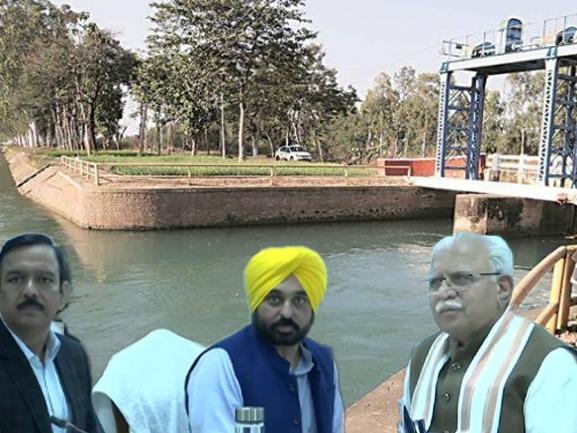Punjab Chief Minister Bhagwant Mann on Friday will be meeting his counterpart from Haryana- Chief Minister Manohar Lal Khattar on the decades-long problem of the SYL. SYL or let's say Sutlej-Yamuna Link canal is a long-standing water dispute between Punjab and Haryana. The SYL meeting between Punjab CM Bhagwant Mann and Haryana CM Manohar Lal Khattar comes after the Supreme Court of India's directive. The Supreme Court of India directed the Punjab CM Mann to meet his Haryana counterpart and come out with an amicable solution over the burning SYL issue.
Now, the question arises, why the apex body directed Punjab CM? The answer is, last month, Harayan told the Supreme Court that Punjab CMs have been reluctant in holding meetings with them. Furthermore, it was also said that Haryana CM wrote a letter to the new CM Bhagwant Mann in April this year, however, received no response. As a result, the Supreme Court of India asked Punjab CM to meet Haryana CM and find an amicable solution to the SYL issue. However, as per the information received, it is unlikely that both states will reach to any conclusion. Seeing the statements given by the sides, no positive outcome is likely to come. While Punjab wants to follow the riparian principle seeing the depletion of its groundwater resources, Haryana wants to exercise its right to drinking as well as irrigation water.
What is the SYL issue and why it remains unsolved even after almost 50 years?
The issue dates back to 1966, from the time of the reorganization of Punjab. When the state of Haryana was formed, a need arose to share river waters with the newly formed state. However, Punjab was opposed to sharing the waters of Ravi and Beas with Haryana, citing the riparian principle. For the unversed, the riparian principle suggests that the state through which a river passes has the right to its waters.
Punjab's stance on the SYL issue
To understand Punjab's stance in the SYL issue, let's turn back the clock to 1955, a decade before the formation of Haryana. The water flowing down Ravi and Beas was assessed at 15.85 million acre feet (MAF). The Union government had organised a meeting in 1955 between the three stakeholders — Rajasthan, undivided Punjab and Jammu & Kashmir. While Rajasthan was allotted 8 MAF, undivided Punjab’s share was 7.20 MAF and J&K got 0.65 MAF. A decade after the creation of Haryana, the Centre issued a notification allocating 3.5 MAF to Haryana out of Punjab’s 7.2 MAF. Then again in 19821, the water flowing down Beas and Ravi was pegged at 17.17 MAF, out of which 4.22 MAF was allocated to Punjab, 3.5 MAF to Haryana, and 8.6 MAF to Rajasthan.
What is SYL?
On April 8, 1982, then PM Indira Gandhi launched the construction of the Sutlej-Yamuna Link (SYL) canal with a ceremony in Kapoori village of Patiala district. The SYL canal was launched in order to link the two rivers was to stretch across 214 km — 122 km in Punjab and 92 km in Haryana. However, the Akali Dal staged a massive protest against the SYL and it was called Kapoori Morcha. However, in July 1985, then Prime Minister Rajiv Gandhi and the then Akali Dal chief Sant Harchand Singh Longowal signed an accord agreeing to a new tribunal to assess the water. Notably, the Tribunal, in 1987, recommended an increase in the shares of Punjab and Haryana to 5 MAF and 3.83 MAF, respectively.
However, on August 20, 1985, then Akali Dal chiefLongowal was killed by militants for signing the accord. In fact, in 1990, chief engineer M L Sekhri and Superintending Engineer Avtar Singh Aulakh were killed by militants. Laborers were also shot dead by the militants who were linked to the SYL project, as a result, it's construction came to a halt, with Punjab leaders cautioning the Centre against it.
Water crisis in Punjab and Haryana
The water crisis problem is certainly looming upon both Punjab and Haryana. As per the government's study, many areas in Punjab may go dry after 2029. Courtesy of the over-exploitation of its groundwater for irrigation by growing wheat and paddy worth Rs 70,000 crore every year, about 79 percent area of the state is over-exploited. In fact, out of 138 blocks, 109 blocks are 'over-exploited', two blocks come under 'critical' while five blocks are 'semi-critical' and only 22 blocks are in the 'safe' category. As a result, the Punjab Government is not likely to share the water.
On the other hand, Haryana has been facing problems in providing water for irrigation. As a result, the state has been staking claim on Ravi-Beas waters through the SYL canal. Furthermore, in southern parts of Haryana the underground water has depleted up to 1700 feet, and as a result, there is a problem with drinking water.
